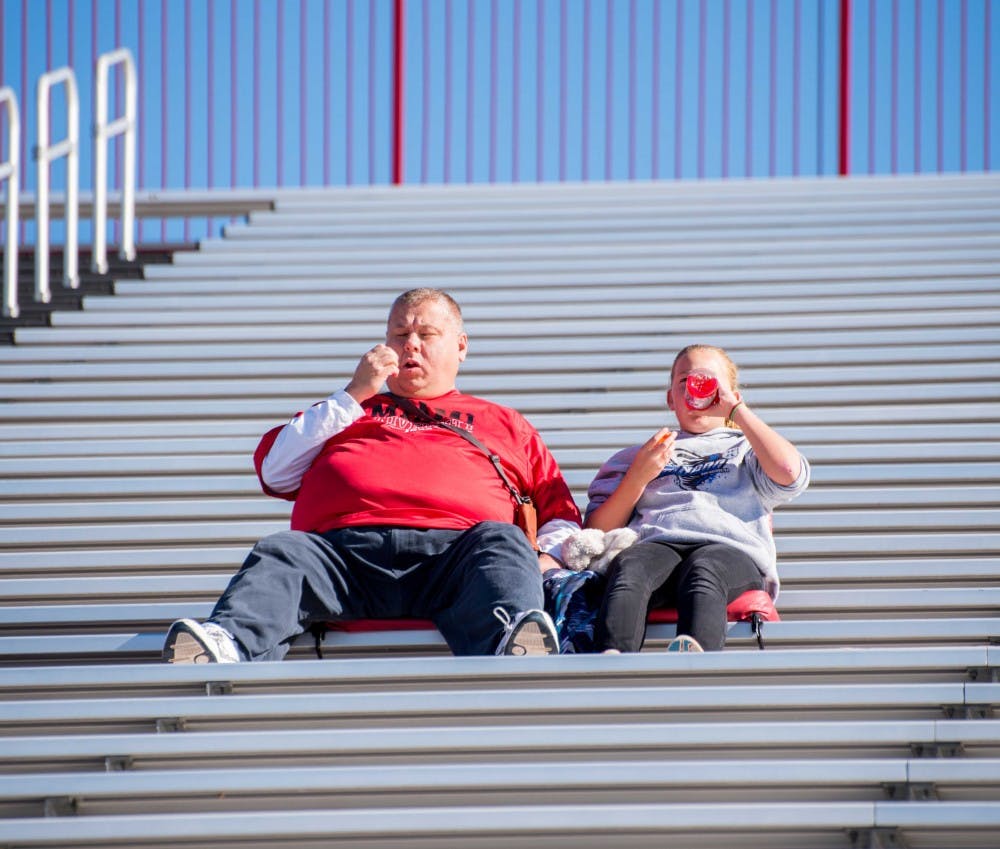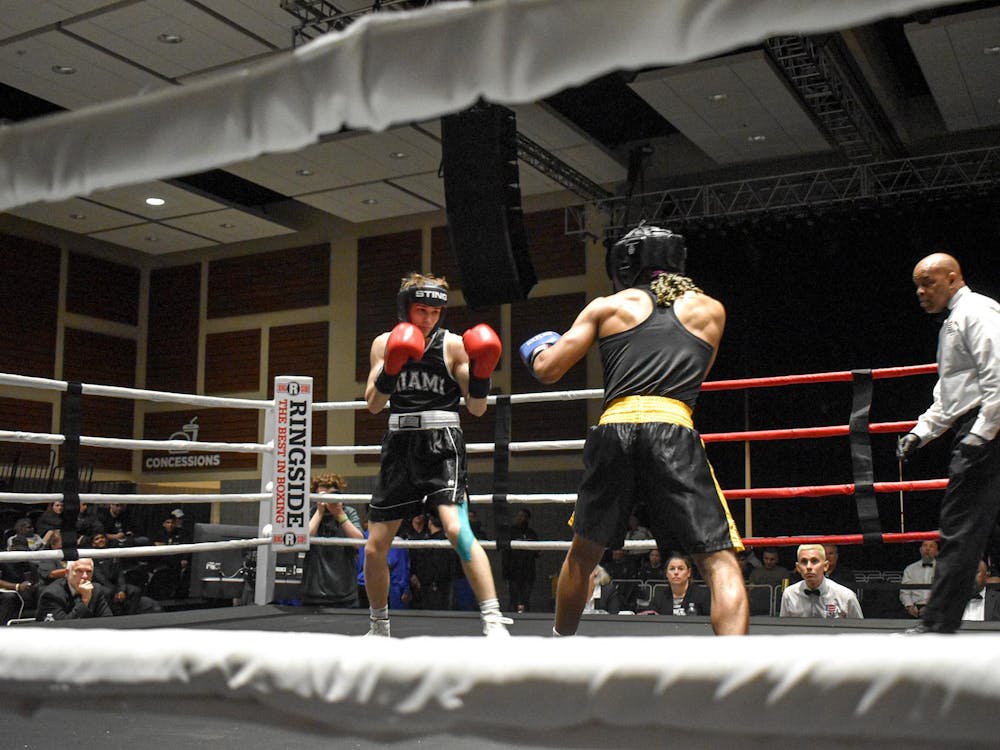A survey by The Student tries to find the answer
By Grace Remington, Former Sports Editor
It's no secret that Miami University students favor other activities over attending a RedHawk football game on a fall Saturday.
Yager Stadium's average of 15,707 total fans per game last season ranked 115th of 128 NCAA Division I football programs.
In an anecdotal survey of current Miami students by The Miami Student, 56.4 percent of respondents said they did not attend a home game during the 2015 season, and 19.2 percent said they attended one game.
Students were asked to choose their reasons for not attending games. Respondents could choose as many reasons as applicable. "Miami is not a winning team" was the top reason, garnering 179 of 250 responses. "My friends don't go to games" was the second highest reason with 171 votes, and "alcohol is not served at the stadium or allowed at tailgates" was third with 125 votes.
Students want a winning team
The RedHawks haven't provided much entertainment for students, having won five games in the last three seasons. They've had one winning season in the last decade.
Seniors Cory Pisano and Dan Perssons, junior Courtney Berry and first-year Abigail Murray said they would rather drive two hours to Columbus for an Ohio State game than walk down the road to a Miami game.
"You want to be on the winning team," Murray said. "OSU is huge. Everybody else is a fan, so you want to be a fan."
Pisano and Perssons agreed.
"It's not fun to watch your team lose," Perssons said. "That's why everyone goes to hockey games, I feel like. Because they've been good for a long time."
Enjoy what you're reading?
Signup for our newsletter
In the Mid-American Conference, it's not often that one program enjoys consistent dominance. The conference leader fluctuates each season.
Miami Deputy Athletic Director Jude Killy said one reason for this could be coaching and administration switches. Frequently, after a school wins the MAC championship, the head coach will leave for a bigger and better job.
"Transition at the top makes it really really tough to sustain [success]," he said. "You hire a successor, then you hire another successor and another successor. I mean, how many runs in a row can you make?"
But, Killy believes MU has the right staff in place to bring a winning team back to Oxford. Miami's investment in new facilities helps with recruitment, and Miami's last two recruiting classes under head coach Chuck Martin have landed in the top three of the MAC.
The Miami culture doesn't include football
A quick drive down High Street on a Saturday is enough to prove Miami students view football in Oxford as an afterthought.
"Over time, it's just developed into everyone coming Uptown on Saturdays rather than going to the football game," Pisano said. "That's just what you adapt to when you come in here as a freshman."
In the TMS survey, several respondents mentioned in a write-in section that Miami doesn't provide a "game-day experience."
"If you go to a hockey game here, everybody knows the chants, and if you don't know the chants, you feel left out," Berry said. "I doubt there would be any chants being taught at a [Miami] football game ... there's always so much fun stuff going on in Oxford that a day game or night game doesn't matter."
In 2010, Ohio University created the Bobcat Student Park, which includes music, games and free food for students. In the Park's first three years, OU saw its student attendance at football games rise from about 3,500 per game to 6,000, according to the Columbus Dispatch.
Miami has tried something similar with the "Endzone" near the West Millet parking lot and is in the process of evaluating its effectiveness with students.
University of Cincinnati, Miami's local and biggest non-conference rival, has a contrasting scene.
"Everybody looks forward to Saturdays," UC junior Ryan Anthony said. "In the student section, everyone is standing and they pack people in there like sardines."
UC President Santa Ono attends games in a red suit and once crowd-surfed the student section. Before a game against University of Houston, the UC athletic department spray-painted a car with Houston colors and had students take a sledge hammer to it.
"It makes people excited about the game, whether they care about football or not," Anthony said. "People know it's a fun thing revolving around our school and that it's like 'my friends are going to go to it, so I'm going to go to it.'"
Students want alcohol
Thirty-four Football Bowl Subdivision schools sell alcohol at games. Five of them belong to the MAC: Akron, Bowling Green, Kent State, Massachusetts and Toledo. Cincinnati also sells alcohol.
Only UMass and Kent State had lower attendance than Miami, and both of those schools had a 3-9 season.
"Kids love tailgates ... kids want to day-drink," Murray said. "If you want kids at games, you need to bring the day-drinking to the games."
University at Buffalo does not allow alcohol in its stadium, but it does allow alcohol at tailgates. Jordan Grossman, UB junior and sports editor of the UB Spectrum, said tailgating helps draw in students.
"I think the biggest benefactor for any sporting event is alcohol," Grossman said. "If you're not able to sit down and have a drink - as crazy as it sounds - it kinda defeats the purpose, at least for college students. Most of them don't go to watch a game."
Killy said he doesn't know if alcohol will be sold at Yager anytime soon.
"Miami's culture is to go drinking on Saturdays, so [game time is] prime drinking time," Perssons said. "I feel like it's that way everywhere, but especially at Miami, because people say it's a drinking town with a college problem."
Does attendance at Yager Stadium affect the players?
Former Miami tight end Orlando David said having a crowd is a "game changer," but it's not the players' job to focus on the stands.
Two other former players agree with David, to an extent.
"When we go to stadiums that are actually filled up, we have more energy," former Miami linebacker Kevin Johnson said. "We haven't really had a home crowd except for like two games freshman year, and that was UC and OU. I can honestly say we were hyped for those games because the crowd was there."
Johnson and Brison Burris, a former defensive back for Miami, said a full stadium certainly helps motivate players, though it's not a predictor for the outcome of a game.
"Fans help get us ready for games. Coming out seeing a full crowd like the UC games gets you going faster than coming out and only seeing close to a classroom size of fans," Burris said.
But, Burris said the low attendance becomes expected after a while. He and teammates once counted 45 fans in the stands at a game.
"If you're an older guy on the team, you kind of know what to be expected and you know everyone is at the bars," he said. "But for the new guys, it's always a shock to see no one in the stands at a college football game."
It's not just a Miami problem
Across the nation, student attendance at football games has dropped, including at Power Five schools. According to a CBS Sports study in December 2015, last year's average attendance among all FBS schools was the lowest since 2000.
"Nationally, it's raised some eyebrows," Killy said. "There's probably a million things that go into it ... certainly the number of things to do and places to go and organizations to participate in has dramatically expanded."
Television is also seen as competition.
"The 300-plus channels you have on TV to watch things in the comfort of your own home and living experience and surroundings," Killy said. "You don't have to get up and do anything, with the advancement of technology, to be able to access so many games."
Attendance is a bigger problem in the MAC, though.
MAC football programs made up half of the bottom ten teams in the nation. Aggregate attendance, which sums the entire number of fans per game and divides that number by MAC members, makes the conference the worst in the FBS. The MAC averages 15,333 fans between its 13 programs.
Grossman cited national recognition as part of the problem.
"We're not in a Power Five conference," he said. "You won't see a MAC school on TV on a Saturday afternoon."
Ohio University had the highest average attendance in the Mid-American last season (21,323), ranking 94th in the country. To put that in perspective, the FBS average was 43,288 and the Southeastern Conference average was 78,720.
Cincinnati has seen the exact opposite of the national trend.
According to the CBS Sports study, UC's attendance increased by 29 percent this year. Nippert Stadium's capacity is 35,000, but it averaged 37,096 fans per game in 2015.
Akron also defeated the national trend, seeing a 97 percent increase in its attendance in 2015 for an average of 18,908. It's worth noting Akron had a winning record and reached a bowl game for its first time since 2005.
At Miami, Killy said the culture won't shift overnight. The solution is a multi-pronged approach to provide a good product on the field, a good game-day experience and additional incentives.
"We all love this place. Our students love this place, our faculty and staff love this place, and Miami football can be a great rallying point to share that pride," Killy said. "We just need to provide enough compelling reasons for them to do that."




